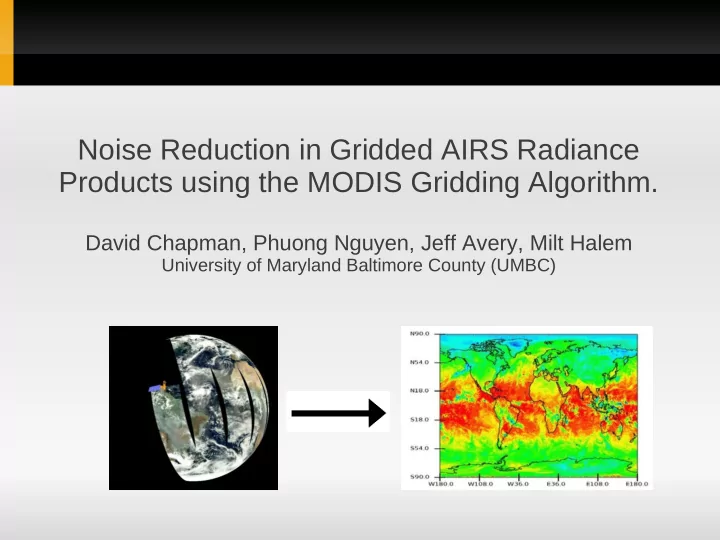

Noise Reduction in Gridded AIRS Radiance Products using the MODIS Gridding Algorithm. David Chapman, Phuong Nguyen, Jeff Avery, Milt Halem University of Maryland Baltimore County (UMBC)
Introduction Gridded data is easier to work with Corrects MANY distortions due to orbit Secondary distortions still remain Gridding introduces errors Footprints never align perfectly with grid cells Reduced data content 11x less data volume AIRS 360x360 Radiance Grid
Forward Gridding Algorithm Forward gridding is a simple approach where footprints are treated as point samples, and placed entirely into a grid box, if the center falls within the cell. Unrealistic, observations are measured within the Instantaneous Field of View (IFOV). Footprints have a distribution of spatial responsiveness called the Point Spread Function PSF.
MODIS Obscov Algorithm Measurements are not point samples. PSF measures sensor responsivity within the IFOV. How much does footprint overlap gridcell? Integral of footprint PSF over grid-cell Use Implicit PSF approximation (triangle) ~12 Billion Integrals/Day
AIRS Tophat functions Two methods to perform spatial calibration with AIRS: 14KM Circle Approximation 'Tophat' Dataset Measured by Elliot, Overoye, Pagano and others Schreier showed improvement with MODIS calibration over Circle
Numeric Obscov with AIRS Tophats
Comparison with Monte Carlo
Intercomparison With MODIS ~190 MODIS footprints per AIRS footprint Calibration mean difference depends on channel centroid differences Linear Re-calibration to match means and standard deviations
Spectral Convolution of AIRS Channels to simulate MODIS Image Borrowed from Knuteson et al. “Atmospheric Radiation Measurement site atmospheric state best estimates for Atmospheric Infrared Sounder temperature and water vapor retrieval validation”
Chan 32 Convolved AIRS - MODIS
Chan 36 Convolved AIRS - MODIS
Convolved AIRS - MODIS Winter Windows
Systematic Yearly Gridding Bias
Summary The MODIS Obscov Algorithm applied numerically to AIRS Fast numeric algorithm using AMR for “Tophat” functions Approximate PSF still slightly better Artifact Improvements via MODIS inter-comparison Primarily due to clouds or cloud boundaries Significant effects 0.2 K/week 0.1K/month 0.5K/year latitudinal belt RMS improvement] Not as important for non-surface channels Systematic latitudinal yearly bias ~0.15K per latitude ~1K over Mountains ~0.5K Land/ocean ~0.3K intertropical clouds Extremely regular
Backup
Introduction Does Obscov make a significant difference for AIRS? Subtraction If so, which one is better? Must compare to “ground truth” Inter comparison with MODIS (1KM spatial footprint) But can we inter-calibrate precisely enough? How does gridding affect longer timeseries information Day / Week / Month / Season / Year / Decade
Recommend
More recommend